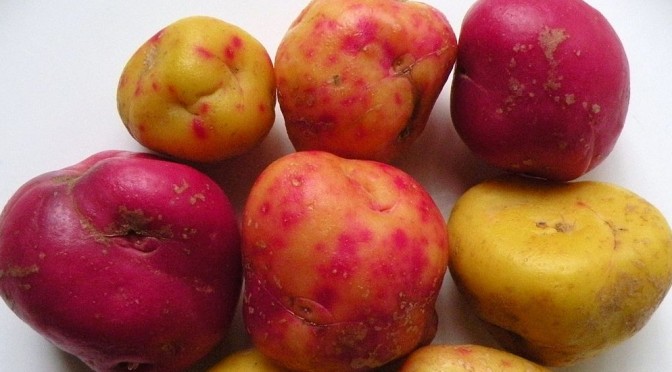I freely admit it. The “U” entry is a definite challenge. In fact, the lower end of the alphabet is a challenge!
I wanted a vegetable that began with “u” and there aren’t a lot of them. But I learned about this one called ulluku, pronounced ou-ju-koo, that hails from the Andes and is basically available in South America and New Zealand. I was in Lima, Peru on business twice in the late 1990’s and it’s quite possible I may have eaten it in one of the fabulous Peruvian meals that I enjoyed while I was there along with Inca Cola, which isn’t a cola at all, but rather a deliciously light beverage made from lemon verbena and is loaded with sugar and caffeine. But I digress.
Ulluku is a tuber that resembles jicama, which I discussed earlier, in that it is crisp and remains crisp, even when cooked. I have not seen it in the United States, but some cities that have more than one Peruvian restaurant might see a dish made with it on the menu. I am sure someone must import it and places like Los Angeles, San Francisco, and New York might have it in a specialty market. However, if you want to try a Peruvian recipe, the recommended substitute for it is jicama.
While I knew the potato was a new world crop, I hadn’t realized that it, too, came from the Andes where the Incas grew them long before the Spanish arrived. The potato made great headway in the world, but the ulluku needs a better publicist because it is a bit scarce. The colorful vegetable does have other names, such as papalisa and milluku in Bolivia, Ecuador, and Peru and as chugua and uyucos in Columbia, while Venezuela refers to them as ruba. They are actually a very important food crop in Peru, coming in second to potatoes in dietary value. They contain high levels of protein, calcium, and carotene. Unfortunately, they also are a little higher in carbohydrates than I like, but still lower than potatoes.
Nutrition information for 3.5 oz. (100 grams) of ulluku
Calories: 74, Fat: 10, Carbs 14 g Protein: 2.6 g
Ullukus are usually cut into strips and cooked as part of the meals. Because they have a high water content, they don’t bake or fry well, but they can be cooked like a potato in any other way. A popular dish featuring the ulluku is the Peruvian dish olluquito con ch’arki which is Ullukus with Lama meat. You can make it with other meats, so here’s a recipe link from PeruvianFood.com to the version made with carne. I intend to try this recipe using jicama.
Information for this article was pulled from Wikipedia, Revolvy,
Appropedia, Inca Shamanic Glossary, and GourmetSleuth.com.
Photos are from Wikimedia Commons used with permission- top photo: “Ulluco” by Nzfauna – Own work. Licensed under CC BY-SA 3.0 via Wikimedia Commons
The recipe photo is “Olluquito con cerdo y arroz blanco 21042010″ by Dtarazona – Own work. Licensed under GFDL via Wikimedia Commons



‘U’nbelievable! You pulled it off nicely. ‘U’ and ‘Y’ will be my biggest challenge too. Though I’ve got drafts for both.
But, as usual, you wrote a great article!
–Mee (The Chinese Quest)